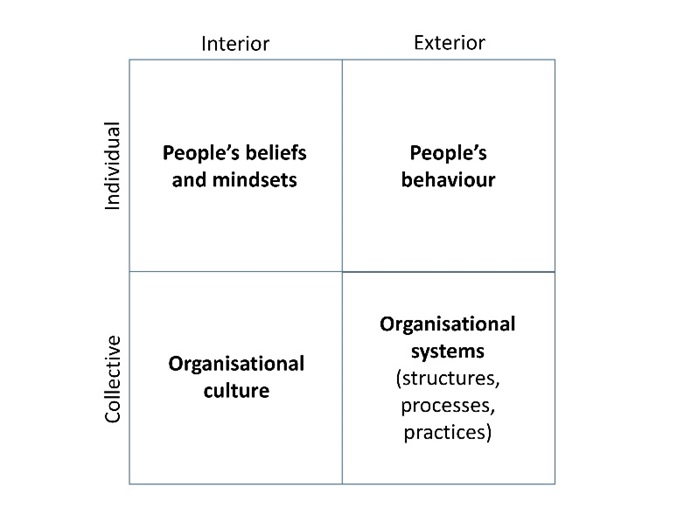There’s something fundamentally wrong with the way the world works. In a series of 5 articles over the next few weeks I’ll share with you why that’s the case, what we need to do about it and how you can begin to implement changes within your own organisation which will start your journey towards a more productive, successful, happier and healthier work environment for all those with a stake in it. The world of work is moving on, don’t get left behind.
In my previous articles I’ve written about why the world of work must change and why more freedom, focus and feedback for employees are the key elements of that change. I’ve shared with you my personal experience of making change happen in an organisation and how that transformed the results for the business and for the people that worked there.
If it’s so great, why isn’t everyone doing it?
You may well be asking yourself by now, given the positive outcomes, why organisations continue to operate in ways which limit the autonomy employees have and fail to provide clear focus and feedback. But people don’t always change things that aren’t working and the existing ways of working are often there for good reason: they reflect the way many people see the world.
The existing ways of working are often there for good reason: they reflect the way many people see the world.
Moving away from a way of working that feels as though it gives you control can seem extremely dangerous.
Change in itself is also difficult. So sometimes, if something isn’t seen to be having a negative impact in the short-term, changing it can seem to be a huge risk and certainly not something you’d prioritise over the next quarter’s results.
So we often continue to do stuff that’s bad for us or our organisations because we can’t yet see a better alternative. Until we’re confident about the way forward, it often feels safer to do nothing, especially if few other people are changing so radically.
Is your organisation ready to embrace the change?
Everyone sees the world in their own unique way. When it comes to transforming an organisation’s culture, the way senior leaders in particular think about the world matters, because they often have the greatest influence over the organisational systems in place.
For example if a business leader believes that people work primarily for money and will do what it takes to make as much money as possible, then it makes perfect sense to use commission schemes or performance-related pay to motivate increased levels of performance. Conversely it would appear nonsensical and high risk to them to replace that system with one that aimed to motivate people through a greater focus on purpose.
In his book Reinventing Organisations, Frederic Laloux applied Wilber’s integral theory of reality to organisations to show how these internal perspectives of reality impact on the external perspectives such as behaviour. Therefore to be really effective, any redesign of an organisation has to impact all four of the quadrants (below), and once they are aligned you’ll find that the different perspectives will continually reinforce each other.

Image courtesy of orghacking.com
Laloux’s view is that it simply isn’t possible to completely transform an organisation in which the leader and the owners don’t have a view of the world that supports those different ways of working. This isn’t just because of the resistance that may be faced trying to implement radical change, but because the new ways of working need to be consistently supported at a senior level in order to really be effective and sustainable.
However there are improved work practices that can be introduced in every organisation that will give individuals and teams more freedom and create a healthier and more successful work environment. What works in your organisation will depend upon the existing culture and mindsets (the ‘interior’ perspectives in Laloux’s quadrant).
Exploring the assumptions we make about others
There will of course be a range of different world views held by people in any organisation but it’s likely that one will dominate and inform the culture. It’s important to understand what that dominant view is and how you can work with the existing culture.
A good way to explore this further is to ask people to consider a particular choice they’ve made and what assumptions guided their choice, why did they feel it was the best choice. This is a technique known as Assumption Surfacing’ and you can find out more about it here.
Many organisations that have successfully redesigned the way they work, have found it valuable to be very explicit about the assumptions they make. For example French manufacturing company FAVI operates on self-managing principles and has defined three clear assumptions:
- People are systematically considered to be good
- There is no performance without happiness
- Value is created on the shop floor
These assumptions guide every single decision that is made at FAVI and, because they are a self-managing organisation, those decisions can be made by anyone and everyone throughout the business so that guidance is important.
Gaining support for your initiatives
Once you’ve identified what the guiding assumptions are within your organisation, there are many ways to introduce and encourage the discussion of your ideas and of course different ways will work for different people. The discussions you have around assumptions may already have led people to start to think differently.
Sharing books and articles with others and encouraging them to do the same can be helpful. You’ll probably know already who enjoys exploring new management ideas and who doesn’t, but short articles from the press often go down well with everyone.
You can share case studies that explore what’s happened in other organisations and what results have been achieved, as experience has more credibility than academic theory for some. And visits to other organisations that are doing things differently can also be a great way to introduce new ideas in a practical way.
Perhaps you could also present an idea in abstract to others (rather than as a proposal for action), to create an opportunity for general discussion and debate about the issues.
Be prepared
People will challenge your ideas, particularly when they don’t fit with their world view. The very idea of giving more freedom to employees about where and when they work is counter cultural in most organisations.
How will we know whether anyone is doing any work? How will we contact people? These are very real concerns and shouldn’t be ignored. But how do you know whether anyone is doing any work now?
I’d imagine that it’s because you see the results of what they do rather than because you see them sat in front of a computer in the office. People have invented a myriad of ways of not working when in the office, but it’s very difficult to avoid producing the required outcomes if that’s clearly where everyone’s focus is.
Always be prepared to answer questions openly. Ensure you ask questions too, to really understand what’s at the heart of people’s concerns. Provide evidence wherever possible, and try to help people identify the real risks around the change and talk about how those can be managed.
Next time…..
I’ll look at ways that will help you identify the particular changes you can make in your own organisation given your culture and the dominant world view, and what else may need to be revised to reinforce them.







One Response
Every person has his/her own
Every person has his/her own way to see the world. When it comes to transform the organization’s culture, the way senior leaders in think about the world matters, because they often have the greatest influence over the organizational systems in place. Via – http://www.synechron.com